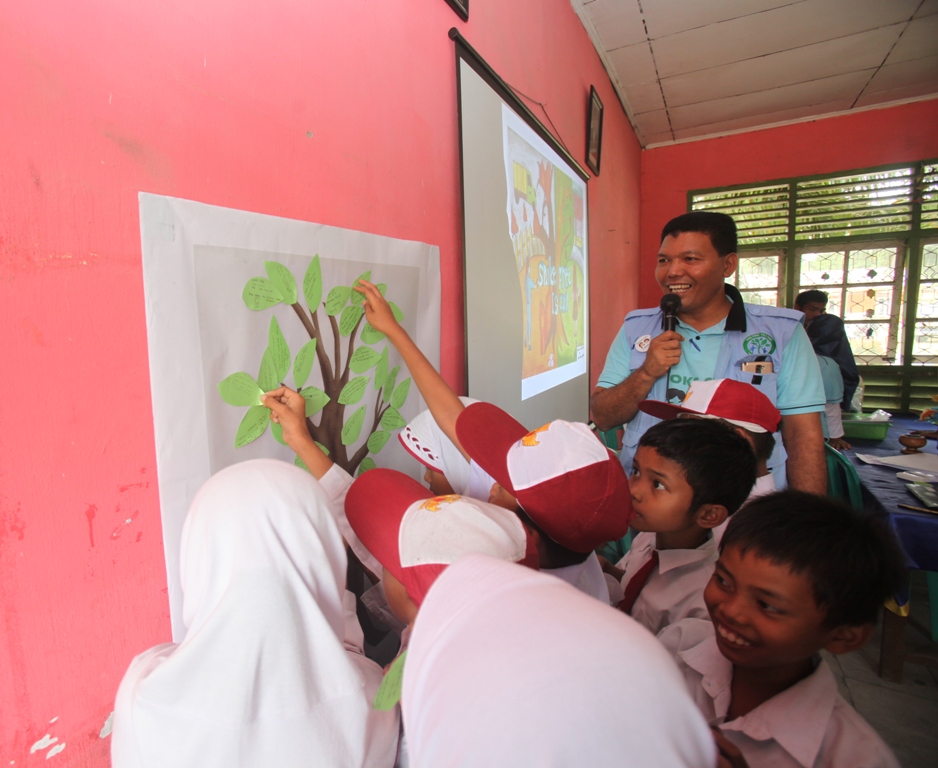Riau Students Take Home Important Lessons for a Fire-free Future
“We must listen to our children.” For Pak Musri, the head of Teluk Binjai village, this is the simple, compelling explanation of the importance of APRIL’s Fire Free Village Schools Programme and the role it can play in preventing fires in Riau province.
The schools programme was launched last year as one of a range of Fire Free Village Programme (FFVP) community awareness initiatives. In 2016, the programme reached 2,513 children in 50 elementary schools across Riau Province, and was called out for its positive impact in the independent review of last year’s FFVP that was conducted by Carbon Conservation (CC). Eighteen of the schools visited belonged to villages participating in the FFVP with the remainder forming part of the broader Fire Aware Communities programme.
The programme continues in 2017, with a further 1,944 children from 28 elementary schools learning about the importance of a fire-free landscape as part of general studies and taking this message home to discuss with their families. Later this year, another version of the programme will be rolled out to 18 junior high schools in the province.
The schools programme was initiated by APRIL in late 2015 when APRIL’s corporate communications and community development teams linked up with the Pekanbaru-based NGO Blue Green and proposed to the Ministry of Education that it become part of the school syllabus in Riau province. It received quick approval from education officials when they learned it was part of the long-term vision to prevent fires and stop haze in the region.
At the heart of the elementary programme is a comic book that would capture the interest of students and help them appreciate the importance of the issue and the benefits of a fire free landscape.

Sailal Arimi explaining APRIL’s Fire Free Village Program (FFVP) at a school in Riau
“The comic book was very important because we needed to talk to the children in their language but we also needed them to understand the issue in the same way that government, NGOs and teachers do,” explained Sailal Arimi, APRIL Fire Prevention Manager, who led the team working with Blue Green.
The book features the characters Bunga (“Flower Girl”) and Alam (“Nature Boy”) who relate a story about the impact of fire on their health and learning, and how the solution to the haze is to stop the fires.
However, as Sailal explains, the messages were not just aimed at the students. “We knew that children could be a big influence on their parents and that many would go home and say ‘please no more burning’. I think many times it was an emotional conversation,” he says.
Blue Green teams visited a number of elementary schools each day together with Riana Ekawati, a full-time member of APRIL’s Fire Free Village team. The visits included teaching about caring for the environment, how fire threatens animals, and the dangers to human health of haze and low quality air. At the end of each visit, children were invited to draw a poster reflecting their experiences with fires and haze.
A week or two later, the schools were re-visited to see the children’s posters and award prizes. “When we saw the posters, we were very happy and surprised at how much they understood the problem. It was clear that the children were very interested in this issue,” said Sailal.
In August and September, the programme will move into its first junior high schools phase. Several short films have been developed instead of the comic book and rather than a poster, older students will be asked to write essays to demonstrate their understanding of the importance of fire and haze prevention.
Sailal says the company will continue with the programme with a focus on not only reaching the children and their families but also in helping teachers to understand how best to communicate fire prevention education as an ongoing part of their responsibilities. Educating younger generations will also help establish new behaviors to counter the age-old practice of burning to clear land, and this is key to achieving long-term change.
For Pak Musri, the programme’s importance is self-evident: “If we just explain laws and regulations to children they don’t understand — but doing it this way, they get it. That will help us all in the future.”




